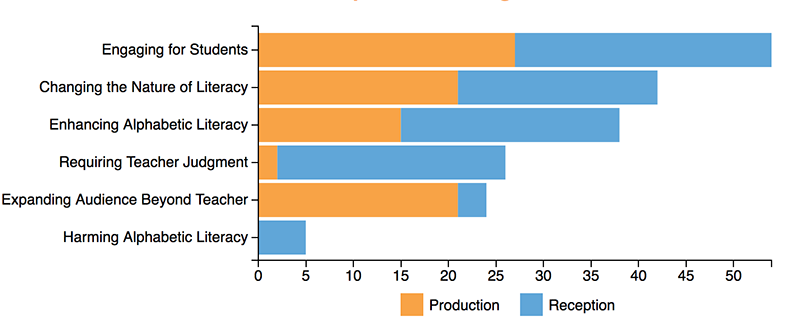Visualizing the Archive
Radio
Radio: Production vs. Reception Over Time
Instructions: Click legend below the graph to turn lines on and off. Double click or pinch graph to zoom in. Drag graph to move through time. Hover over the dots to make hyperlinked citations to the articles appear; hover over a new dot to make citation info boxes go away. Click link at top of graph to reset.
X = year; Y = number of articles
-
Click to view graph data in table format
Radio Reception Table
Radio Production Table
A quick look at the timeline above indicates that interest in radio-based pedagogy largely ran from the 1930s through the early 1950s—with a few minor bursts later on. This span roughly parallels what is commonly known as the Golden Age of Radio, a period characterized by narrative-driven radio dramas (e.g., Dragnet, The Shadow), broadcast news, variety shows, and other types of non-musical programming. During this period, while there was plenty of emphasis on reception (e.g., listening appreciation, writing reviews of radio plays, and the like), production regularly kept apace, and in some years—1939, 1941, and 1942 in particular—even eclipsed reception. Most of these articles described assignments and collaborative class projects where students wrote, produced, and performed their own radio scripts. In some cases, teachers such as Doris Nelson and Wanda Orton solicited the aid of local radio stations to broadcast such performances, and in other cases, students used the school’s local intercom system to “narrowcast” their programs. Some teachers who didn’t have access to radio technology would lead their students in creating mock radio studios where the class would perform their scripts for a live audience, going so far as to employ “hacks” of everyday objects to emulate studio equipment.
The high-water mark for radio, just before its precipitous plunge in 1952, was 1949, which saw no fewer than six articles on radio, all of them emphasizing reception. Here we notice a trend in terms of lifespan that other media tend to follow: an initial interest in production eventually gives way to reception. Of course, this waxing/waning effect doesn’t happen in a vacuum, as other, newer media emerge and capture our collective pedagogical imagination; in this case, attention to radio-based production falls away alongside the growth of television. Although peak interest in radio ended in the early 1950s (thanks a lot, television!), sporadic interest continued to crop up throughout the timeline in decades subsequent to radio’s salad days: two in the 1960s and 1970s, one in the 1980s, and three in the 1990s. These precursors eventually gave way to more recent interest in podcasting, audio essays, and other digital audio production projects assigned in the classroom.
Topoi for Teaching with Radio

X = number of articles; Y = topoi
-
Click to view graph data in table format
Topoi for Teaching with Radio
Radio Topos Production Reception Engaging for Students 27 27 Changing the Nature of Literacy 21 21 Enhancing Alphabetic Literacy 15 23 Requiring Teacher Judgment 2 24 Expanding Audience Beyond Teacher 21 3 Harming Alphabetic Literacy 0 5
When we look at the various topoi articulated by teachers using radio, a number of interesting observations emerge. For one, we notice the relatively small number of articles expressing the negative opinion that radio was harmful for students in their efforts to acquire alphabetic literacy skills. With the exception of a few naysayers, English teachers most frequently framed radio pedagogy via positive topoi: that teaching radio is engaging for students, changing the nature of literacy (typically framed positively), and enhancing alphabetic literacy. When we consider how the topoi break down according to production versus reception, the division is roughly equal for the most frequent topoi, but there are two instances in which the topoi clearly skew in one direction. “Requiring the moral/aesthetic judgment of the teacher” is decidedly a reception-oriented topos at 24 to 2, while “expanding audience beyond the teacher” is a production-focused topos at 21 to 3—and in many ways this topos continues to animate conversations about digital audio production in the field today.
Taken together, both our radio graphs demonstrate the longstanding interest English teachers have had in radio production, vividly reminding us that we are not the first generation of English teachers to engage meaningfully and deeply with audio pedagogies. We can also see how the early spike in radio production pedagogy dwindled quite quickly to be resurrected only much later on a much smaller scale. The graphs suggest a possible story of how the initial burst of enthusiasm for radio production pedagogy in the field was dampened as teachers went back to more traditional approaches that positioned radio as simply another kind of text to be analyzed and evaluated—a story that might begin to reveal some of the reasons why media production pedagogies have often not been sustained in the field.
Although we are making some preliminary claims about the evolution of radio pedagogies based on these graphs alone, we find that the graphs are most useful not for the definitive stories they tell but rather for the intriguing questions they raise. As we play with these graphs, we find ourselves wondering: What motivated teachers to engage so deeply with radio production in the 1930s and why did they move away from production as the 1940s rolled in? What exactly did radio production look like in the context of a 1930s English class? Why was there a mild resurgence of radio pedagogies in the 1970s, 1980s, and 1990s? How did teachers approach radio differently at these later points in radio’s lifespan? How did radio pedagogies intersect with other audio composing technologies that are not pictured on these medium-specific graphs? We take up these questions and more in chapter 4, “Listening to Audio Pedagogies.”
